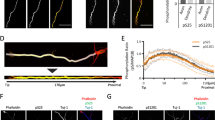Abstract
Microtubules and microfilament patterns in cultured astrocytes were revealed by using indirect immunofluorescent microscopy in conjunction with anti-tubulin immune serum and anti-actin immunoglobulins respectively. In flat epitheloid astroglial cells (either polygonal or elongated) colchicine-sensitive immunofluorescent fibres, which correspond to bundles of microtubules, extend from the perinuclear cytoplasm into the cell periphery by running for long distances through the different focal planes. These patterns of organization differ markedly from the patterns of organization of microfilaments which are arranged in fibres parallel to each other and often oriented along the cell boundary. In response to the combined treatments of serum withdrawal and administration of dBcAMP, flat epitheloid astrocytes adopt a morphology similar to that of the mature astrocytes in situ in the CNS, that is of stellate process-bearing cells. This is prevented or is reverted by the administration of colchicine at the appropriate times. There are strong suggestions indicating that during cell processes formation the microtubular network is reorganized and microtubules assembled into dense bundles which are oriented along the axis of the cell processes. In view of these results, we suggest that, in contrast to microfilaments, microtubules are not determinant for the maintenance of cellular shape in elongated or polygonal flat epitheloid astroglial cells but they are required for both the formation and maintenance of processes in stellate astrocytes.
Similar content being viewed by others
References
Brightman, M. W., andPalay, S. L. 1963. The fine structure of ependyma in the brain of the rat. J. Cell Biol. 18:415–439.
Bignami, A., Dahl, D., andRueger, D. C. 1980. Glial fibrillary acidic protein (GFA) in normal neural cells and in pathological conditions. Adv. Cell. Neurobiol. 1:285–310.
Rueger, D. C., Huston, J. S., Dahl, D., andBignami, A. 1979. Formation of 100 Å filaments from purified glial fibrillary acidic protein in vitro. Mol. Biol. 135:53–68.
Manthorpe, M., Adler, R., andVaron, S. 1979. Development, reactivity and GFA immunofluorescence of astroglia containing monolayer cultures from rat cerebrum. J. Neurocytol. 8:605–621.
Sensenbrenner, M. 1978. Dissociated brain cells in primary cultures. Pages 191–214,in Fedoroff, S. andHertz, L. (eds.), Cell Tissue and Organ Cultures in Neurobiology, Academic Press, New York.
Bock, E. 1978. Nervous system specific proteins. J. Neurochem. 30:7–14.
Lim, R., Troy, S. S., andTuriff, D. E. 1977. Fine structure of cultured glioblasts before and after stimulation by a glia maturation factor. Exp. Cell Res. 106:359–372.
Yamada, K. M., Spooner, B. S., andWessells, N. K. 1970. Axon growth: roles of microfilaments and microtubules. Proc. Nat. Acad. Sci. USA 66:1206–1212.
Roisen, F. J., Murphy, R. A. 1973. Neurite development in vitro. II. The role of microfilaments and microtubules in dibutyryl adenosine 3′,5′-cyclic monophosphate and nerve growth factor stimulated maturation. J. Neurobiol. 4:397–412.
Daniels, M. 1975. The role of microtubules in the growth and stabilization of nerve fibres. Ann. NY Acad. Sci. 253:535–544.
Hesketh, J. E., Ciesielski-Treska, J., andAunis, D. 1981. A phase-contrast and immunofluorescence study of adrenal medullary chromaffin cells in culture: neurite formation, actin and chromaffin granule distribution. Cell Tiss. Res., 218:331–343.
Marchisio, P. C., Osborn, M., andWeber, C. 1978. The intracellular organization of actin and tubulin in cultured C-1300 mouse neuroblastoma cells (clone NB41A3) J. Neurocytol. 7:571–582.
Bader, M. F., Ciesielski-Treska, J., Thierse, D., Hesketh, J. E., andAunis, D. 1981. Immunocytochemical study of microtubules in chromaffin cells in culture and evidence that tubulin is not an integral protein of the chromaffin granule membrane. J. Neurochem. 37:917–933.
Ciesielski-Treska, J., Guerold, B. andAunis, D. 1982. Immunofluorescence study on the organization of actin in astroglial cells in primary cultures. Neuroscience, 7:509–522.
Berkowitz, S. A., Katagiri, J., Binder, H. K., andWilliams, R. C. 1977. Separation and characterization of microtubule proteins from calf brain. Biochemistry 16:5610–5617.
Aunis, D., Guerold, B. Bader, M. F., andCiesielski-Treska, J. 1980. Immunocytochemical and biochemical demonstration of contractile proteins in chromaffin cells in culture. Neuroscience 5:2261–2277.
Lazarides, E. 1976. Actin, α-actinin, and tropomyosin interaction in the structural organization of actin filaments in non-muscle cells. J. Cell Biol. 68:202–219.
Lazarides, E. 1975. Immunofluorescence studies on the structure of actin filaments in tissue culture cells. J. Histochem. Cytochem. 23:507–528.
Weber, K., Pollack, R., andBibring, T. 1975. Antibody against tubulin: The specific visualization of cytoplasmic microtubules in tissue culture cells. Proc. Nat. Acad. Sci. USA 72:459–463.
Clarke, M., andSpudich, J. A. 1977. Non-muscle contractile proteins: the role of actin and myosin in cell motility and shape determination. Ann. Rev. Biochem. 46:797–822.
Jockusch, H., Jockusch, B. M., andBurger, M. M. 1979. Nerve fibers in culture and their interactions with non-neural cells visualized by immunofluorescence. J. Cell Biol. 80:629–641.
Paulin, D., Babinet, C., Weber, K., andOsborn, M. 1980. Antibodies as probes of cellular differentiation and cytoskeletal organization in the mouse blastocyt. Exp. Cell Res. 130:297–304.
Brinkley, B. R., Fuller, G. M., andHighfield, D. P. 1975. Cytoplasmic microtubules in normal and transformed cells in culture. Analysis by tubulin antibody immunofluorescence. Proc. Nat. Acad. Sci. USA 72:4981–4985.
Osborn, M., andWeber, K. 1977. The display of microtubules in transformed cells. Cell 12:561–571.
Spiegelman, B. M., Lopata, M. A., andKirschner, M. W. 1979. Multiple sites for the initiation of microtubules assembly in mammalian cells. Cell 15:239–252.
Sensenbrenner, M., Devilliers, G., andBock, E. 1980. Biochemical and ultrastructural studies of cultured astroglial cells. Effect of brain extract and dibutyryl cyclic AMP on glial fibrillary acidic protein and glial filaments. Differentiation 17:51–61.
Author information
Authors and Affiliations
Rights and permissions
About this article
Cite this article
Ciesielski-Treska, J., Bader, MF. & Aunis, D. Microtubular organization in flat epitheloid and stellate process-bearing astrocytes in culture. Neurochem Res 7, 275–286 (1982). https://doi.org/10.1007/BF00965640
Accepted:
Issue Date:
DOI: https://doi.org/10.1007/BF00965640




